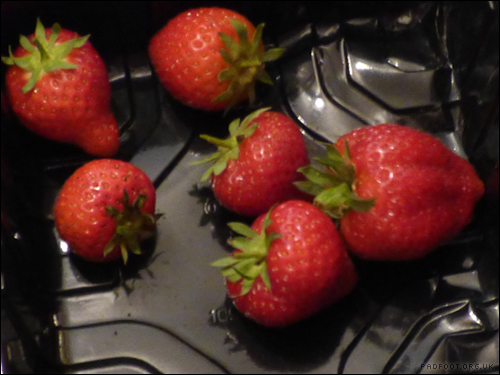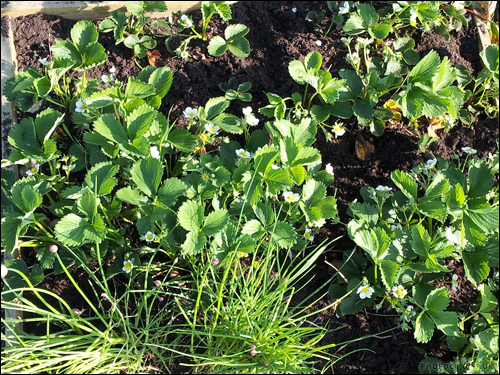One way to get a little piece of wild is to try growing your own fruit or vegetables. I was planning on this post being about growing your own radishes…. but mine went straight to producing flowers, with no radishes to be seen 🙁
So instead, here’s my guide to growing your own strawberries! You don’t need a massive garden to achieve it – just enough space for a small plant pot. The strawberry flowers provide pollen for bees, and once the fruits have ripened, they’re a tasty treat for us humans!

You don’t even need to go to a garden centre to find the plants in the first place – most supermarkets sell strawberry plants, or if you’re really lucky and a neighbour grows strawberries, they might have some small plants (strawberry runners) that they’d let you have for free.
There’s loads of different varieties, and I haven’t a clue what the ones are called that I’m growing. I got 9 plants from an offer in a newspaper a few years ago, and since then I’ve picked lots of tasty strawberries, and also now have a total of 40 plants, plus several others that I’ve given away to friends and neighbours!
So what do you need to get started?
- Soil – you can use multi-purpose compost, or even use a grow bag. Either way, you need something a little better than just soil from the garden. You can usually find this in supermarkets, but if not, then a garden centre or somewhere like Homebase should have plenty available.
- A pot – you can buy special “strawberry planters” but I’ve had great results from just planting them in a large (12 inch) regular pot. Make sure it has drainage holes in the base though! You could also have individual strawberry plants in smaller pots (a 5 inch pot should work really well), or even use a hanging basket – planting the strawberries in the top, allowing the fruits to dangle over the edges for ease of picking.
- “Crocks” to aid drainage – this can be anything from pieces of a broken terracotta pot to those polystyrene packing chips. Just something to stop the water running straight out of the holes in the base of the pot.
- And last but not least, your strawberry plants!
Strawberry plants are more commonly sold as “bare-root runners” (new young plants) in the autumn / early winter, but some varieties are sold during the spring. I purchased 5 more strawberry plants this year, and they arrived last week, so there should still be some available out there. There’s plenty of different varieties out there, ranging from “normal” strawberries to white-fruiting plants, or ones with pink flowers…. generally speaking, the “normal” looking ones should be easier to grow successfully.

Place your crocks into the base of the pot – if you’re using polystyrene packing chips, you don’t need too deep a layer.
Carefully add the multi-purpose compost or grow bag soil. Add it in slowly if you’re using those chips, otherwise it can make them move and you’d have to start over again!
Once you’ve got the pot full to about 1 inch off the top, stop filling it! Gently ease your strawberry plant from it’s existing pot (or if it’s a bare-rooted runner, just take it from any packaging it arrived in). You don’t want the soil level to be any higher up the plant than it is at the moment (for bare-rooted runners, you just need the roots under the soil).
Make a hole in the soil that would fit the roots into – the bigger the plant, the bigger the hole (obviously).
Place the strawberry plant into the hole, and top it up with more soil to fill any gaps.
Press down firmly to make sure there’s no air pockets.
Put your plant pot in it’s final location, and water the plants thoroughly.
If you plant them in the winter, most strawberry runners will fruit the following summer (or if you buy slightly more established strawberry plants, they can be planted in the spring and should still fruit that summer).
You do want to cut off any runners (small strawberry plants that grow on a long “running” root) in the first year, so they don’t put all their effort into making young plants!
All you need then is some cream to go with them!
